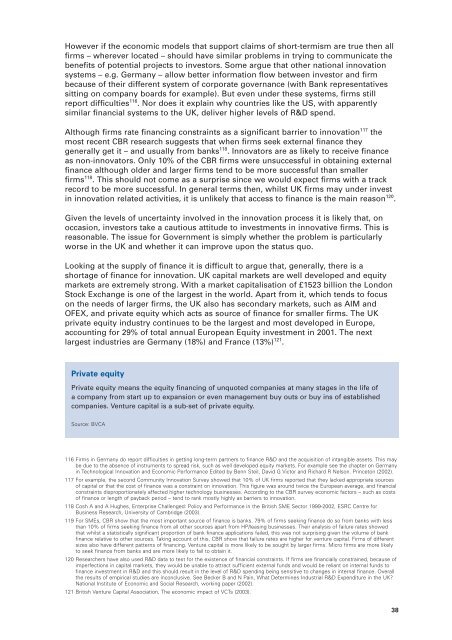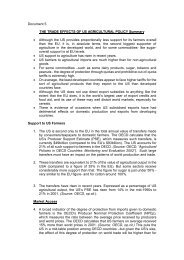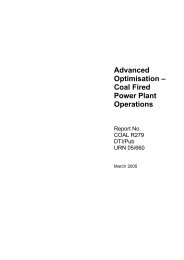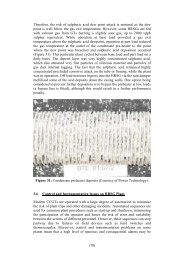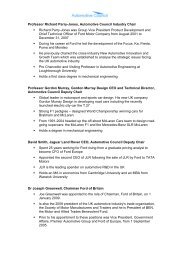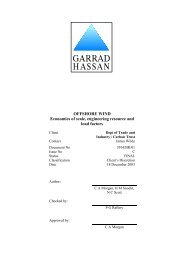Competing in the Global Economy – The Innovation Challenge
Competing in the Global Economy – The Innovation Challenge
Competing in the Global Economy – The Innovation Challenge
Create successful ePaper yourself
Turn your PDF publications into a flip-book with our unique Google optimized e-Paper software.
However if <strong>the</strong> economic models that support claims of short-termism are true <strong>the</strong>n all<br />
firms <strong>–</strong> wherever located <strong>–</strong> should have similar problems <strong>in</strong> try<strong>in</strong>g to communicate <strong>the</strong><br />
benefits of potential projects to <strong>in</strong>vestors. Some argue that o<strong>the</strong>r national <strong>in</strong>novation<br />
systems <strong>–</strong> e.g. Germany <strong>–</strong> allow better <strong>in</strong>formation flow between <strong>in</strong>vestor and firm<br />
because of <strong>the</strong>ir different system of corporate governance (with Bank representatives<br />
sitt<strong>in</strong>g on company boards for example). But even under <strong>the</strong>se systems, firms still<br />
report difficulties 116 . Nor does it expla<strong>in</strong> why countries like <strong>the</strong> US, with apparently<br />
similar f<strong>in</strong>ancial systems to <strong>the</strong> UK, deliver higher levels of R&D spend.<br />
Although firms rate f<strong>in</strong>anc<strong>in</strong>g constra<strong>in</strong>ts as a significant barrier to <strong>in</strong>novation 117 <strong>the</strong><br />
most recent CBR research suggests that when firms seek external f<strong>in</strong>ance <strong>the</strong>y<br />
generally get it <strong>–</strong> and usually from banks 118 . Innovators are as likely to receive f<strong>in</strong>ance<br />
as non-<strong>in</strong>novators. Only 10% of <strong>the</strong> CBR firms were unsuccessful <strong>in</strong> obta<strong>in</strong><strong>in</strong>g external<br />
f<strong>in</strong>ance although older and larger firms tend to be more successful than smaller<br />
firms 118 . This should not come as a surprise s<strong>in</strong>ce we would expect firms with a track<br />
record to be more successful. In general terms <strong>the</strong>n, whilst UK firms may under <strong>in</strong>vest<br />
<strong>in</strong> <strong>in</strong>novation related activities, it is unlikely that access to f<strong>in</strong>ance is <strong>the</strong> ma<strong>in</strong> reason 120 .<br />
Given <strong>the</strong> levels of uncerta<strong>in</strong>ty <strong>in</strong>volved <strong>in</strong> <strong>the</strong> <strong>in</strong>novation process it is likely that, on<br />
occasion, <strong>in</strong>vestors take a cautious attitude to <strong>in</strong>vestments <strong>in</strong> <strong>in</strong>novative firms. This is<br />
reasonable. <strong>The</strong> issue for Government is simply whe<strong>the</strong>r <strong>the</strong> problem is particularly<br />
worse <strong>in</strong> <strong>the</strong> UK and whe<strong>the</strong>r it can improve upon <strong>the</strong> status quo.<br />
Look<strong>in</strong>g at <strong>the</strong> supply of f<strong>in</strong>ance it is difficult to argue that, generally, <strong>the</strong>re is a<br />
shortage of f<strong>in</strong>ance for <strong>in</strong>novation. UK capital markets are well developed and equity<br />
markets are extremely strong. With a market capitalisation of £1523 billion <strong>the</strong> London<br />
Stock Exchange is one of <strong>the</strong> largest <strong>in</strong> <strong>the</strong> world. Apart from it, which tends to focus<br />
on <strong>the</strong> needs of larger firms, <strong>the</strong> UK also has secondary markets, such as AIM and<br />
OFEX, and private equity which acts as source of f<strong>in</strong>ance for smaller firms. <strong>The</strong> UK<br />
private equity <strong>in</strong>dustry cont<strong>in</strong>ues to be <strong>the</strong> largest and most developed <strong>in</strong> Europe,<br />
account<strong>in</strong>g for 29% of total annual European Equity <strong>in</strong>vestment <strong>in</strong> 2001. <strong>The</strong> next<br />
largest <strong>in</strong>dustries are Germany (18%) and France (13%) 121 .<br />
Private equity<br />
Private equity means <strong>the</strong> equity f<strong>in</strong>anc<strong>in</strong>g of unquoted companies at many stages <strong>in</strong> <strong>the</strong> life of<br />
a company from start up to expansion or even management buy outs or buy <strong>in</strong>s of established<br />
companies. Venture capital is a sub-set of private equity.<br />
Source: BVCA<br />
116 Firms <strong>in</strong> Germany do report difficulties <strong>in</strong> gett<strong>in</strong>g long-term partners to f<strong>in</strong>ance R&D and <strong>the</strong> acquisition of <strong>in</strong>tangible assets. This may<br />
be due to <strong>the</strong> absence of <strong>in</strong>struments to spread risk, such as well developed equity markets. For example see <strong>the</strong> chapter on Germany<br />
<strong>in</strong> Technological <strong>Innovation</strong> and Economic Performance Edited by Benn Steil, David G Victor and Richard R Nelson. Pr<strong>in</strong>ceton (2002).<br />
117 For example, <strong>the</strong> second Community <strong>Innovation</strong> Survey showed that 10% of UK firms reported that <strong>the</strong>y lacked appropriate sources<br />
of capital or that <strong>the</strong> cost of f<strong>in</strong>ance was a constra<strong>in</strong>t on <strong>in</strong>novation. This figure was around twice <strong>the</strong> European average, and f<strong>in</strong>ancial<br />
constra<strong>in</strong>ts disproportionately affected higher technology bus<strong>in</strong>esses. Accord<strong>in</strong>g to <strong>the</strong> CBR survey economic factors <strong>–</strong> such as costs<br />
of f<strong>in</strong>ance or length of payback period <strong>–</strong> tend to rank mostly highly as barriers to <strong>in</strong>novation.<br />
118 Cosh A and A Hughes, Enterprise <strong>Challenge</strong>d: Policy and Performance <strong>in</strong> <strong>the</strong> British SME Sector 1999-2002, ESRC Centre for<br />
Bus<strong>in</strong>ess Research, University of Cambridge (2003).<br />
119 For SMEs, CBR show that <strong>the</strong> most important source of f<strong>in</strong>ance is banks. 79% of firms seek<strong>in</strong>g f<strong>in</strong>ance do so from banks with less<br />
than 10% of firms seek<strong>in</strong>g f<strong>in</strong>ance from all o<strong>the</strong>r sources apart from HP/leas<strong>in</strong>g bus<strong>in</strong>esses. <strong>The</strong>ir analysis of failure rates showed<br />
that whilst a statistically significant proportion of bank f<strong>in</strong>ance applications failed, this was not surpris<strong>in</strong>g given <strong>the</strong> volume of bank<br />
f<strong>in</strong>ance relative to o<strong>the</strong>r sources. Tak<strong>in</strong>g account of this, CBR show that failure rates are higher for venture capital. Firms of different<br />
sizes also have different patterns of f<strong>in</strong>anc<strong>in</strong>g. Venture capital is more likely to be sought by larger firms. Micro firms are more likely<br />
to seek f<strong>in</strong>ance from banks and are more likely to fail to obta<strong>in</strong> it.<br />
120 Researchers have also used R&D data to test for <strong>the</strong> existence of f<strong>in</strong>ancial constra<strong>in</strong>ts. If firms are f<strong>in</strong>ancially constra<strong>in</strong>ed, because of<br />
imperfections <strong>in</strong> capital markets, <strong>the</strong>y would be unable to attract sufficient external funds and would be reliant on <strong>in</strong>ternal funds to<br />
f<strong>in</strong>ance <strong>in</strong>vestment <strong>in</strong> R&D and this should result <strong>in</strong> <strong>the</strong> level of R&D spend<strong>in</strong>g be<strong>in</strong>g sensitive to changes <strong>in</strong> <strong>in</strong>ternal f<strong>in</strong>ance. Overall<br />
<strong>the</strong> results of empirical studies are <strong>in</strong>conclusive. See Becker B and N Pa<strong>in</strong>, What Determ<strong>in</strong>es Industrial R&D Expenditure <strong>in</strong> <strong>the</strong> UK?<br />
National Institute of Economic and Social Research, work<strong>in</strong>g paper (2002).<br />
121 British Venture Capital Association, <strong>The</strong> economic impact of VCTs (2003).<br />
38


